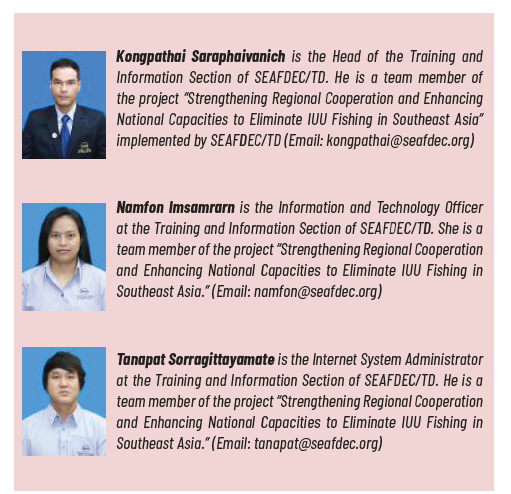Article II 2/2025 - PRACTICAL ISSUES IN THE IMPLEMENTATION OF THE ELECTRONIC ASEAN CATCH DOCUMENTATION SCHEME (eACDS) IN CAPTURE FISHERIES
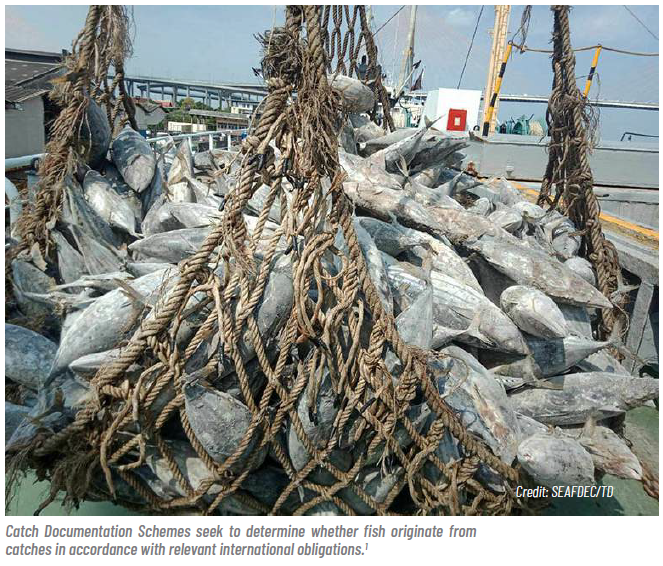
Fishery products are among the most traded goods in the world. In 2021, the total volume was 218 million tonnes, with a value of USD 176 billion. This represents an increase compared to USD 151 billion during the previous year, which was affected by the COVID-19 pandemic. According to FAO statistics from 2017 to 2021, the top three countries with the highest import volumes of aquatic products were the United States of America (17%), China (10%) and Japan (8%); while in Southeast Asia, the top three were Thailand (2.18%), Vietnam (1.18%) and Malaysia (0.77%). As for exports, the leading countries globally were China (12%), Norway (8%) and Vietnam (5%); in Southeast Asia, the top three were Vietnam (5.12%), Thailand (3.06%) and Indonesia (2.99%).
1)The FAO Voluntary Guidelines for Catch Documentation Schemes (VGCDS) is the first international policy document with comprehensive elaboration about CDS.
A major challenge for all countries in monitoring global trade flows is ilegal, unreported and unregulated (IUU) fishing. To ensure the sustainable utilisation of fishery resources, several tools (such as catch documentation schemes) have been developed by Southeast Asian Fisheries Development Center (SEAFDEC) and other organisations. The ASEAN Catch Documentation Scheme (ACDS) is aimed at improving traceability within marine capture fisheries in order to prevent the entry of fish and fishery products from IUU fishing into the supply chain. A regional initiative between the Southeast Asian Fisheries Development Center (SEAFDEC) and the ASEAN Member States (AMS), the ACDS was endorsed at the Twenty-fifth Meeting of the ASEAN Sectoral Working Group on Fisheries (25ASWGFi) in May 2017 in Singapore. Later in the same year, the document was adopted at the Senior Officials Meeting of the ASEAN Ministers on Agriculture and Forestry (SOM-AMAF).
To support the implementation of the ACDS, an electronic system was considered necessary, taking into consideration the guidance from the SEAFDEC Council that the process should not create an unnecessary burden, cost or lengthy process for all supply chain importers/exporters. Accordingly, SEAFDEC initiated the electronic ASEAN Catch Documentation Scheme (eACDS), which was implemented in Brunei Darussalam as a pilot project in 2016 and later launched during the Inaugural Ceremony of the Forty-ninth Meeting of the SEAFDEC Council in June 2017 (Figure 1). Its use was expanded as requested in Myanmar (2018), Vietnam (2018), Malaysia (2019), and Cambodia (2022).

The electronic ASEAN Catch Documentation Scheme (eACDS)
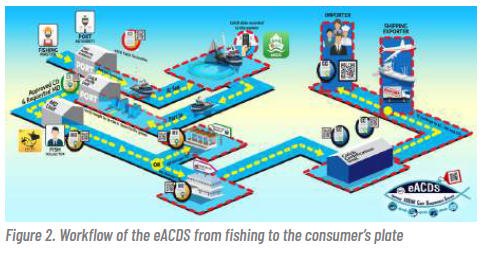
The eACDS operates on two primary platforms:
i. eACDS web application: The eACDS Web Application is designed to serve various user groups involved in fisheries management and traceability. The designated users include: “Fishing Boat Owners or Fishing Masters” (users can access the web application to request port-out and port-in approvals); “Processing Plants or Processors” (can utilise the web application to request Statements of Catch and Catch Certificate documents); and “Government and Authorised Officers” who validate and issue essential certificates, as well as manage data, including approving port-out/port-in and verifying catch weight, issuing Catch Declarations (CD), issuing Movement Documents (MD), issuing Statements of Catch (SC), issuing Catch Certificates (CC), viewing reports and managing Key Data Elements (KDEs) (Figure 3).
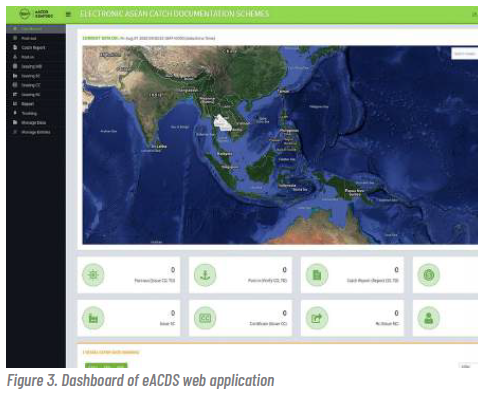
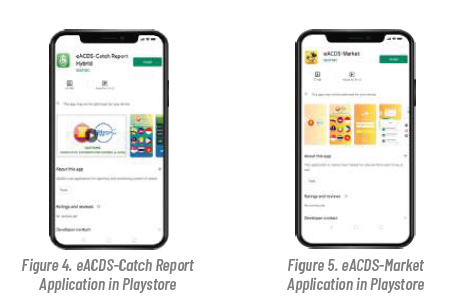
Part 1: Catch Declaration (CD)
Part 2: Movement Document (MD)
Part 3: Statement of Catch (SC)
Part 4: Catch Certification (CC)
For international export documentation, the process is linked to various information through SC, MD, and CD QR-Codes attached to the documents. This system serves as a powerful tool to ensure that fishery products intended for export are not sourced from Illegal, Unreported, and Unregulated (IUU) fishing activities.
Successful implementation in countries
• Introduction - the eACDS system including its structure and functions is demonstrated to relevant authorities and stakeholders in participating countries.
• Baseline survey and situation analysis - baseline survey is carried out, and analysis of the situation in issuing CD, MD, and CC as well as identification of KDEs, is conducted involving relevant authorities and stakeholders in the respective AMSs.
• Prototype development - the eACDS is modified and appropriate prototypes developed taking into consideration the context of the respective AMSs.
• Testing and improving the system - the eACDS is pilot tested with relevant users (e.g., relevant authorities, fishing masters, fishing vessel owners, buyers, and processers) who are trained on the use of the application, and problems addressed in order that the system is tailored to the context of the respective AMSs (Figure 6).
• IT transfer - During the testing phase, all data are stored in the SEAFDEC cloud server, and afterwards, the database would be transferred to, and maintained by, the respective AMSs. Participating countries have reported successful usage of the eACDS application, including installing the application on the cloud server. In fact, Vietnam has developed its electronic catch documentation and traceability (eCDT) system based on the eACDS demonstration.
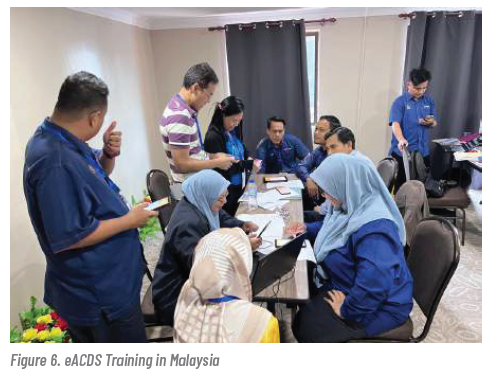
Conclusion
References
• FAO. 2020. Fishery and Aquaculture Statistics – Yearbook 2018. FAO Yearbook of Fishery and Aquaculture Statistics. Rome. https://www.fao.org/fishery/en/publications/269665
• FAO. 2021. Fishery and Aquaculture Statistics – Yearbook 2019. FAO Yearbook of Fishery and Aquaculture Statistics. Rome. https://www.fao.org/fishery/en/publications/287024
• FAO. 2023. Fishery and Aquaculture Statistics – Yearbook 2020. FAO Yearbook of Fishery and Aquaculture Statistics. Rome. https://www.fao.org/fishery/en/publications/306134
• FAO. 2024. Fishery and Aquaculture Statistics – Yearbook 2021. FAO Yearbook of Fishery and Aquaculture Statistics. Rome. https://www.fao.org/fishery/en/publications/313168
• Saraphaivanich, K., Imsamrarn, N., & Suthipol, Y. (2019). Boosting the traceability of ASEAN fish and fishery products through Imsamrarn the eACDS. Fish for the People, 17(3): 23–28
• Saraphaivanich, K., Suthipol, Y., & Imsamrarn, N. (2021). The Development of Traceability systems for Capture Fisheries in Southeast Asia: the eACDS in focus. Fish for the People, 19(3): 11–19
• Secretariat, Southeast Asian Fisheries Development Center. SEAFDEC DATABASE. Fishery Statistics of Southeast Asia. http://map.seafdec.org/NewBulletin/index.php
• Secretariat, Southeast Asian Fisheries Development Center. 2024. Fishery Statistical Bulletin of Southeast Asia 2021. https:// repository.seafdec.org/handle/20.500.12066/7437
• Secretariat, Southeast Asian Fisheries Development Center. 2020- 01. Fishery Statistical Bulletin of Southeast Asia 2020. https:// repository.seafdec.org/handle/20.500.12066/7172
• Secretariat, Southeast Asian Fisheries Development Center. 2022-01. Fishery Statistical Bulletin of Southeast Asia 2019. https:// repository.seafdec.org/handle/20.500.12066/6749
• Secretariat, Southeast Asian Fisheries Development Center. 2020- 12-31. Fishery Statistical Bulletin of Southeast Asia 2018. https:// repository.seafdec.org/handle/20.500.12066/6601
• Secretariat, Southeast Asian Fisheries Development Center. 2020-01. Fishery Statistical Bulletin of Southeast Asia 2017. https:// repository.seafdec.org/handle/20.500.12066/5792
